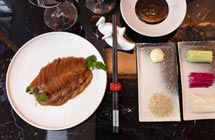北京烤鸭在纽约火了!600多元一只烤鸭,预定排到明年二月!
|
12月11日,北京大董烤鸭的首家海外分店在纽约曼哈顿开张迎客。 脆皮、甜面酱、葱丝、黄瓜……西餐Style的烤鸭,诱人中透着一点高冷…… 这家餐厅的装饰结合了西餐厅的模式,但是也保留了传统的中式风格…… The Manhattan branch has 440 seats, including about 200 on outdoor terraces, sprawled over 17,500 square feet on the building's second and third floors.
和国内不少烤鸭店一样,店里还是可以看到片烤鸭的师傅…… 看餐厅颇为不错的样子,但做什么菜才是关键!我们来看看大董纽约店的菜单。 菜品总共有80多样,其中招牌菜烤鸭,一套“酥不腻”烤鸭98美元(约合人民币648元),半只烤鸭58美元(约合人民币383元),还可以搭配黑鱼子! 大董“酥不腻”烤鸭 DaDong "SuBuNi" Roast Duck ——$98 Whole/ $58 Half Served with Sugar, Pancakes, Crispy Sesame Buns and Special Sauces 价格不菲,但并没有阻挡纽约人民的热情。 据《纽约时报》11月28日报道,预定刚开启了2个小时,就已经排到明年二月份了…… A few weeks ago, within the first two hours of becoming available, 2,500 reservations were booked through February, overloading the phone lines. 这么受欢迎,可能是因为真的很好吃。据彭博生活追求栏目(Bloomberg Pursuits)介绍,大董烤鸭香酥可口、滑而不腻。
scallions ['skæljən]:葱 hoisin:用大豆、糖、醋和大蒜制成的棕红色甜辣酱 该报道还介绍了具体吃法,一份烤鸭可以有四种搭配吃法。(咽口水jpg.) Traditional-style comes with pancake, hoisin, and three to four pieces of duck meat (and skin), as well as watermelon radishes, cucumber, and scallion slices. There's also a sesame-puff bun, a flaky pastry shell that's meant to be stuffed with the duck meat, a pungent garlic paste, and vegetable garnishes. flaky:薄片的 A further option is to dip the duck in a bowl of sugar and eat it plain. Finally, there's the Kaluga caviar accompaniment, which costs an additional $42 and is meant to be spooned between the skin and the meat. caviar:鱼子酱 其实,在大董烤鸭打入纽约之前,北京烤鸭早已享誉海外。 作为最有名的北京菜,烤鸭以色泽红艳、肉质细嫩、味道醇厚、肥而不腻的特色引诱着国内外无数吃货。 外国人对烤鸭的爱从他们的文字描述中就能感受到: Imagine the best Peking Duck you’ve ever had. That crispy, amber-toned skin. That juicy, melt-in-your-mouth breast meat. Those deeply nuanced, deeply aromatic flavors, expertly engineered to send your pleasure sensors spinning. 《孤独星球》(Lonely Planet)还介绍过烤鸭的前世今生: Peking duck was first mentioned in royal cookbooks during the Yuan dynasty (13th century), but didn’t come to the fore until the early 1900s, when former imperial cooks began opening roast duck restaurants outside the palace walls. 也讲解了烤鸭的制作过程: To prepare the duck, chefs first inflate the bird by blowing air between the skin and body. They then prick the skin and pour boiling water over the duck. Some chefs add malt sugar to the skin so that it glows golden brown once roasted. 一些文章甚至还研究过烤鸭的各种派系: Closed oven style 焖炉烤鸭 Peking Duck is originally roasted in a closed oven, and Bianyifang is the restaurant who keeps this tradition. The closed oven is built of brick and is preheated by burning Gaoliang sorghum straw at the base. The duck is placed in the oven immediately after the fire burns out, allowing the meat to be slowly cooked through the convection of heat within the oven. Controlling the fuel and the temperature is the main skill. In closed oven style, duck meat is combined well with the fat under the skin, and therefore is juicy and tender. Open oven style 挂炉烤鸭 The open oven was developed in the imperial kitchens during the Qing Dynasty, and adopted by the Quanjude restaurant chain. It is designed to roast up to 20 ducks at the same time with an open fire fueled by hardwood from peach or pear trees. The ducks are hung on hooks above the fire and roasted at a temperature of 270 °C for 30–40 minutes. In open oven style, the fat is usually melted during the cooking process, so the skin is crispy, and can be eaten separately as a snack. 总之,烤鸭做起来非常复杂,绝对不是一道家常菜,但是外国人却写了不少文章,教大家如何自制烤鸭……
但是自己做的烤鸭哪有大北京的地道,于是各国游客来北京必尝烤鸭。 网上有各种热情洋溢的攻略指南帖:
1971年7月,基辛格作为美国总统尼克松的特使来到北京,与周恩来总理举行秘密会谈。周总理请他吃北京烤鸭,一度紧张的会谈气氛在基辛格吃过这道人间美味后立刻缓和。
“After a dinner of Peking duck, I'll agree to anything.” 当然,北京美食绝不止烤鸭一种,下面是《孤独星球》和一些外媒盘点的北京菜,一起来看看有没有你爱吃的…… 炸酱面 Zhajiang noodles
To balance out the addictive saltiness of the chunky sauce, fresh vegetables are laid to the side - julienned cucumber, crunchy radish and, in modern Beijing, juicy bean sprouts or edamame (fresh soybeans). chunky:厚实的 julienned:切丝的 radish:萝卜 bean sprout:豆芽 edamame:毛豆 You lovingly turn the toppings through the noodles to reach the flavour-to-noodle ratio of your liking and quietly slurp away. 豆汁儿 Mung-bean milk
Sometimes translated as ‘soymilk’, Beijing’s dòuzhī is actually made from mung beans, has a mild sourness to it and isn’t sweet like soymilk. You’ll find dòuzhī throughout the city, from street stalls to restaurants, and it warrants a taste to find out if you are a dòuzhī lover or hater. To help mung-bean milk go down, try it with the usual accompaniment of strips of spicy pickles. Beijingers swear by the health benefits of protein- and fiber-rich dòuzhī and claim that it cools you down on a stifling Beijing summer’s day and warms you up in winter. pickles:咸菜 炒肝儿 Stir-fried pork liver
The traditional way to eat chǎo gānr is by sipping its salty mushroom broth directly from the bowl. You may need the spoon for the chewy lungs and intestines. intestines:内脏、下水 This Beijing speciality isn’t subtle – it’s sprinkled with raw garlic and is served for breakfast. Yes, breakfast. 爆肚 Quick-fried Tripe
By adding cooking oil, sesame sauce, Chinese vinegar, chili oil, bean paste and small pieces of vegetables, the dish is ready to serve. 焦圈 Fried Rings
To make good jiaoquan, one must pay attention to what wheat they use. It is said the Zhangjiakou wheat is the best choice as the wheat is red and can make for the crispy taste. Mixing edible alkali into the wheat is also suggested. edible alkali:食用碱 豌豆黄 Pea Flour Cake As one part of Beijing culture, pea flour cake is a sort of traditional snack of Beijing, taking in spring under Beijing custom. It is light yellow and tastes sweet and cool, just smelting in your mouth. Its making process is as follows: grind up the pea, take off the skins, clean them up, boil until soft, frozen-up, finally cut into pieces. It is said that pea flour cake is favored by Empress Dowager Cixi, hence even more famous. |









